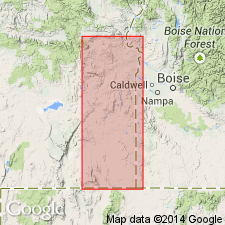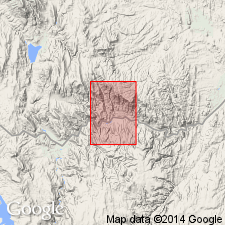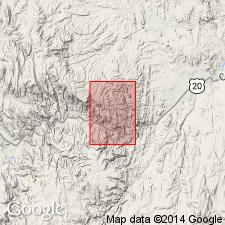
- Usage in publication:
-
- Hunter Creek Basalt
- Modifications:
-
- Named
- Dominant lithology:
-
- Basalt
- AAPG geologic province:
-
- Snake River basin
Summary:
Named for Hunter Creek. Type locality designated as exposures on Hunter Creek in SW/4 SW/4 NW/4 sec.26 T21S R39E, Malheur Co, OR. Exposed extensively in Monument Peak, Mahleur Gorge, and Harper Basin districts, usually as stone-striped slopes and domical hills. Consists of felty, microcrystalline, intergranular, intersertal basalt. Contains one to several flows. Thickness ranges from 3 to 400 ft; is 150 ft at type locality. Commonly rests on Dinner Creek Welded Ash-Flow Tuff (new); underlies Littlefield Rhyolite (new). Overlain indirectly by Butte Creek Volcanic Sandstone (new) which contains Barstovian fossils. Regional correlation chart shows age to be Miocene.
Source: GNU records (USGS DDS-6; Menlo GNULEX).

- Usage in publication:
-
- Hunter Creek Basalt*
- Modifications:
-
- Adopted
- AAPG geologic province:
-
- Snake River basin
Summary:
Hunter Creek Basalt of Kittleman and others (1965) adopted. Shown in northeast corner (T. 19 through 22 S., R. 38 E.) of geologic map of Burns 1 x 2 deg. quadrangle, Oregon. Described as basalt, dark-gray, aphanitic and aphyric; shows characteristic closely spaced columnar jointing and flow jointing. Maximum thickness is 140 feet. Overlies Dinner Creek Welded Tuff. Underlies Tims Peak Basalt. Age is Miocene.
Source: GNU records (USGS DDS-6; Menlo GNULEX).

- Usage in publication:
-
- Hunter Creek Basalt*
- Modifications:
-
- Areal extent
- AAPG geologic province:
-
- Snake River basin
Summary:
(advance copy). Unit is extended into report area (Jonesboro 7.5-min quadrangle, Malheur County, Oregon). Age is middle Miocene.
Source: GNU records (USGS DDS-6; Menlo GNULEX).

- Usage in publication:
-
- Hunter Creek Basalt*
- Modifications:
-
- Areal extent
- AAPG geologic province:
-
- Snake River basin
Summary:
(advance copy). Unit is extended into report area (South Mountain 7.5-min quadrangle, Malheur Co., OR). Age is middle Miocene.
Source: GNU records (USGS DDS-6; Menlo GNULEX).
For more information, please contact Nancy Stamm, Geologic Names Committee Secretary.
Asterisk (*) indicates published by U.S. Geological Survey authors.
"No current usage" (†) implies that a name has been abandoned or has fallen into disuse. Former usage and, if known, replacement name given in parentheses ( ).
Slash (/) indicates name conflicts with nomenclatural guidelines (CSN, 1933; ACSN, 1961, 1970; NACSN, 1983, 2005, 2021). May be explained within brackets ([ ]).

